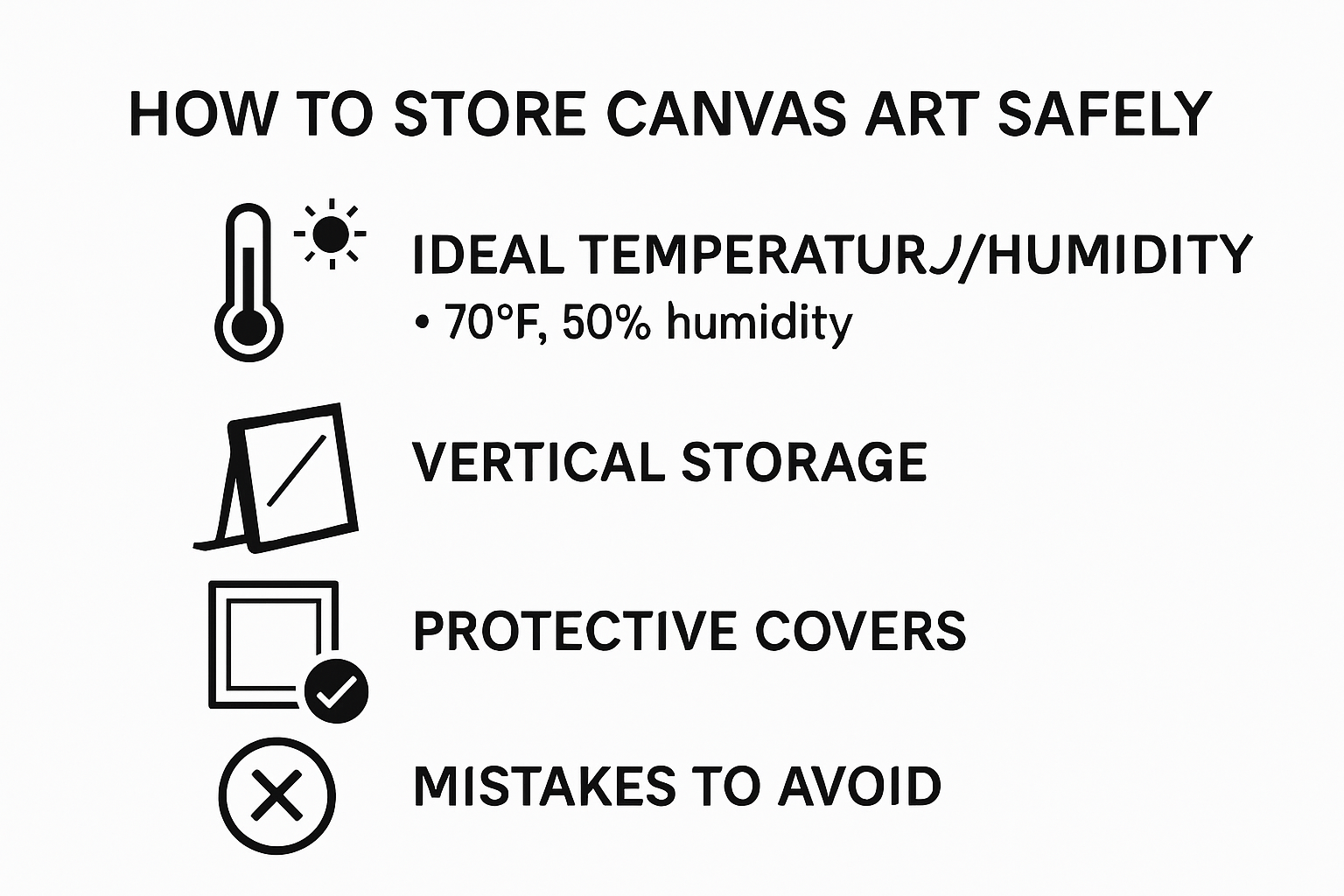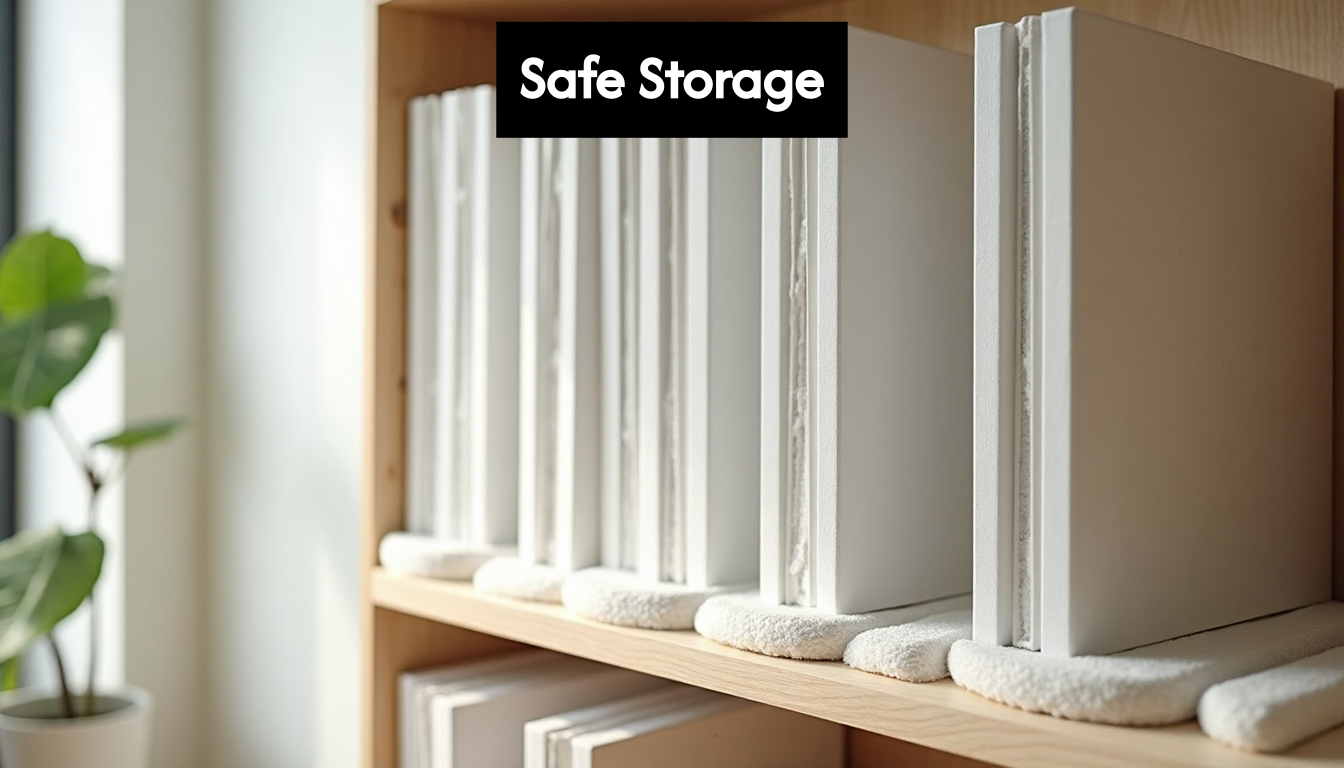
How to Store Canvas: Protect Modern Art & Luxury Prints 2025

Protecting canvas art involves more than careful handling. A canvas stored in a humid room is up to 60 percent more likely to grow mold or suffer damage compared to one kept in stable conditions. That sounds extreme, right? Here’s what most people miss. The real danger usually comes from everyday storage habits like stacking canvases horizontally or hiding them in closets. These silent mistakes quietly threaten even the most valuable art. See what truly matters if you want your artwork looking vibrant for years.
Table of Contents
- Choosing The Right Environment For Canvas Art
- Best Materials And Methods For Safe Canvas Storage
- Tips For Storing Large, Framed, Or Specialty Canvases
- Common Mistakes To Avoid When Storing Canvas Prints
Quick Summary
| Takeaway | Explanation |
|---|---|
| Maintain Controlled Environment | Keep canvas art in a climate-controlled space, ideally between 65-75°F with 45-55% humidity to prevent damage. |
| Use Appropriate Storage Covers | Opt for breathable, acid-free storage covers to avoid moisture buildup and chemical reactions that can harm the artwork. |
| Store Vertically with Spacing | Always store canvases upright with sufficient spacing between them to prevent warping and physical damage. |
| Implement Air Quality Management | Use air purifiers and avoid storing in dusty areas like attics or basements to protect artworks from airborne contaminants. |
| Avoid Common Mistakes | Prevent exposure to direct sunlight and improper positioning by storing artworks away from windows and never laying them flat for longer periods. |

Choosing the Right Environment for Canvas Art
Storing canvas art requires strategic planning and careful environmental management. The right conditions can preserve your artwork’s beauty and integrity for decades, while poor storage can lead to irreversible damage.
Temperature and Humidity Control
Artwork preservation begins with understanding environmental dynamics. Experts recommend maintaining a consistent climate controlled environment with temperatures between 65-75°F (18-24°C) and relative humidity levels between 45-55%. These precise parameters prevent multiple potential risks.
Temperature fluctuations cause significant stress on canvas materials. Extreme heat can cause canvas fibers to expand, while cold temperatures make them contract. This continuous movement weakens the artwork’s structural integrity. Rapid humidity changes pose equally serious threats. High moisture levels encourage mold growth, while excessive dryness can cause canvas cracking and pigment deterioration.
Light and UV Protection
Sunlight exposure represents one of the most destructive environmental factors for canvas art. Research indicates that direct UV rays can permanently fade pigments and degrade artistic materials. When selecting storage spaces, prioritize areas with minimal natural light or invest in UV-protective coverings.
Consider these strategic storage recommendations:
- Location Strategy: Choose interior rooms without direct sunlight access
- Covering Protection: Use acid-free archival covers to block potential light damage
- Rotation Management: Periodically rotate stored artworks to prevent uneven exposure
Air Quality and Preservation
Preservation experts emphasize the critical role of air quality in artwork conservation. Dust, pollutants, and airborne contaminants can scratch delicate canvas surfaces or trigger chemical reactions that compromise artistic integrity.
Implement air filtration systems in storage areas to minimize particulate matter. Avoid storing artwork in basements, attics, or spaces prone to dust accumulation. Consider using museum-grade air purifiers designed specifically for art preservation. These systems remove microscopic particles that could potentially damage your valuable canvas pieces.
Proper environment selection transforms storage from a basic necessity into an active preservation strategy. By understanding and controlling temperature, humidity, light exposure, and air quality, you create a protective ecosystem that maintains your artwork’s original beauty and value.
Best Materials and Methods for Safe Canvas Storage

Protecting canvas art requires more than just finding a storage space. The right materials and methods can mean the difference between preserving a cherished artwork and accidentally causing irreparable damage.
Selecting Optimal Storage Covers
Experts recommend using breathable, water-repellent covers specifically designed for art preservation. Plastic wraps are a strict no-go for long-term storage. These non-breathable materials trap moisture, creating an environment that can lead to mold growth, canvas warping, and pigment degradation.
Instead, invest in specialized art storage covers that offer several key benefits:
- Breathability: Allows air circulation to prevent moisture buildup
- Transparent Sections: Enables artwork identification without unpacking
- Acid-Free Materials: Prevents chemical reactions that could damage the canvas
When selecting storage covers, prioritize materials that protect without compromising the artwork’s ability to breathe. Cotton or muslin cloths with protective properties work exceptionally well for canvas art storage.
Positioning and Storage Techniques
Art preservation specialists strongly advise against storing canvases in common household spaces like under beds, behind furniture, or in crowded closets. These locations expose artwork to dust, dirt, and potential physical damage.
The ideal storage method involves:
- Vertical Storage: Keep canvases standing upright to prevent warping
- Spacing: Ensure artworks are not tightly packed or touching each other
- Padding: Use soft, archival-quality materials between canvases for additional protection
Bubble wrap might seem like a quick solution, but it is only suitable for short-term transportation. For long-term storage, its lack of breathability makes it an unsuitable option for canvas art preservation.
Professional Storage Solutions
For truly valuable or delicate artworks, consider professional art storage facilities. These specialized environments offer controlled temperature, humidity, and light conditions that are difficult to replicate at home.
Professional storage typically includes:
- Climate-controlled rooms
- Dust-free environments
- Security systems
- Specialized handling equipment
If professional storage is not feasible, create a dedicated art storage area in your home that mimics these professional conditions. Use archival-grade shelving, maintain consistent environmental controls, and implement a systematic approach to artwork organization.
Remember, proper storage is an investment in preserving the artistic value, emotional significance, and potential future worth of your canvas art. By choosing the right materials and methods, you protect not just a piece of art, but a piece of creativity and expression that can be cherished for generations.
Tips for Storing Large, Framed, or Specialty Canvases
Large canvases and specialty art pieces require unique storage considerations that go beyond standard preservation techniques. Their size, weight, and delicate nature demand specialized handling and protection strategies.
Proper Positioning and Support
Canvas storage experts emphasize the critical importance of positioning large artworks. Unlike smaller pieces, large canvases should always be stored upright on their edges, never flat. This positioning prevents unnecessary pressure on the canvas surface and reduces the risk of warping or structural damage.
When storing large canvases, implement these critical support techniques:
- Storage Racks: Use professional-grade art storage racks that provide individual support
- Vertical Spacing: Ensure artworks are not touching each other
- Even Weight Distribution: Use padded supports that distribute weight evenly
Maintain a consistent environmental condition with temperatures between 65-75°F and humidity levels of 40-60%. Extreme fluctuations can cause irreparable damage to large canvas pieces, particularly those with intricate frames or specialized mounting.
Protective Wrapping and Packaging
Preservation specialists recommend using specialized wrapping materials that offer breathability and protection. Avoid plastic wraps entirely, as they trap moisture and can cause significant damage to artwork.
Instead, use these recommended wrapping materials:
- Cotton Sheets: Soft, breathable, and gentle on canvas surfaces
- Acid-Free Paper: Provides a protective barrier against dust and pollutants
- Archival Tissue: Offers additional cushioning without chemical interactions
For added protection, consider using acid-free boxes or specialized mirror boxes designed for large artworks. Fill any gaps with crumpled acid-free paper to prevent movement during storage. Critically, label these containers with “FRAGILE” and “UP” markings to ensure proper handling.
Specialized Handling for Unique Canvases
Some canvases require extra attention due to their unique characteristics. Textured paintings, mixed media pieces, or artworks with delicate embellishments need more sophisticated storage approaches.
Special considerations include:
- Texture Protection: Use soft, non-abrasive materials that won’t disturb raised surfaces
- Frame Preservation: Provide additional padding for ornate or delicate frames
- Mixed Media Caution: Avoid compression that might damage three-dimensional elements
For particularly valuable or fragile pieces, professional art storage facilities offer climate-controlled environments with specialized handling equipment. These facilities provide the most comprehensive protection for unique and irreplaceable canvases.
Remember that proper storage is an investment in preserving artistic integrity. By implementing these specialized techniques, you protect not just the physical artwork, but the creative expression and emotional value captured within each unique canvas piece.
Common Mistakes to Avoid When Storing Canvas Prints
Preserving canvas prints requires more than good intentions. Many art collectors unknowingly damage their valuable artwork through seemingly innocent storage practices that can compromise the piece’s long-term integrity and aesthetic value.
Lighting and Environmental Exposure
Art preservation experts warn that direct sunlight represents one of the most destructive environmental factors for canvas prints. Ultraviolet rays can cause irreversible damage, gradually fading colors and weakening canvas materials.
Common lighting-related mistakes include:
- Window Proximity: Storing artwork near windows with direct sunlight
- Unprotected Display: Hanging prints in brightly lit areas without UV protection
- Inconsistent Light Exposure: Allowing uneven light distribution across the artwork
To mitigate these risks, always store canvas prints in shaded areas with consistent, indirect lighting. Consider using UV-protective coverings or storing artwork in rooms with controlled light exposure.
Improper Storage Positioning
Canvas preservation specialists emphasize that horizontal storage is a critical error many art owners make. Laying canvas prints flat can cause significant long-term damage, including sagging, dust accumulation, and permanent stretcher bar impressions.
Key positioning mistakes to avoid:
- Flat Storage: Never store canvases horizontally for extended periods
- Tight Stacking: Avoid pressing prints against each other
- Uneven Support: Ensure artwork has consistent, balanced support
The recommended approach is always vertical storage with appropriate spacing between pieces. This method prevents unnecessary pressure and allows for proper air circulation.
Climate Control Negligence
Conservation research indicates that inconsistent humidity and temperature are silent destroyers of canvas artwork. Extreme conditions can cause molecular-level damage that becomes visible only after significant deterioration.
Critical climate-related mistakes include:
- Humidity Extremes: Storing artwork in areas with humidity above 60% or below 35%
- Temperature Fluctuations: Exposing prints to rapid temperature changes
- Poor Ventilation: Storing artwork in poorly circulated spaces
Maintain a consistent environment with temperatures around 69°F (21°C) and relative humidity near 50%. Use dehumidifiers, air conditioners, or specialized art storage solutions to create a stable preservation environment.
Remember that avoiding these common mistakes is not about perfection but about mindful preservation. Each canvas print represents an artistic expression worth protecting. By understanding and implementing proper storage techniques, you safeguard not just the physical artwork, but the creative vision captured within its canvas.
Frequently Asked Questions
What is the ideal temperature and humidity for storing canvas art?
Keep canvas art in a climate-controlled environment with temperatures between 65-75°F and relative humidity levels between 45-55% to prevent damage such as mold growth or cracking.
How should I position my canvases when storing them?
Canvases should be stored vertically with enough spacing between each piece to prevent warping and physical damage. Avoid storing them flat or tightly packed together.
What materials are best for covering stored canvas artwork?
Use breathable, acid-free storage covers made from cotton or muslin to protect your canvases. Avoid plastic wraps as they trap moisture and can cause damage.
What common mistakes should I avoid when storing canvas prints?
Avoid storing canvas prints near sunlight, laying them flat for long periods, and neglecting climate control. These practices can lead to fading, warping, and other irreversible damage.
Preserve What Matters: Elevate Your Canvas Art and Storage Standards
Are you worried about keeping your modern art and luxury canvas prints safe from damage? This article uncovered exactly how unpredictable humidity, sunlight, and basic storage mistakes can quietly destroy even your most cherished pieces. If you want your canvas prints to remain as stunning as the day you brought them home, it is time to take action and choose art meant to last.

Invest in artwork created with professional preservation in mind. At Marta Ellie, you will find canvas prints made for both display and long-term beauty. Every piece is crafted with high-quality materials so you are not just buying art—you are choosing dependable quality you can trust. Explore new arrivals to discover pieces worthy of safe storage and memorable display. Act today to give your collection the secure foundation it deserves and let Marta Ellie’s artistry enrich your life for years to come.